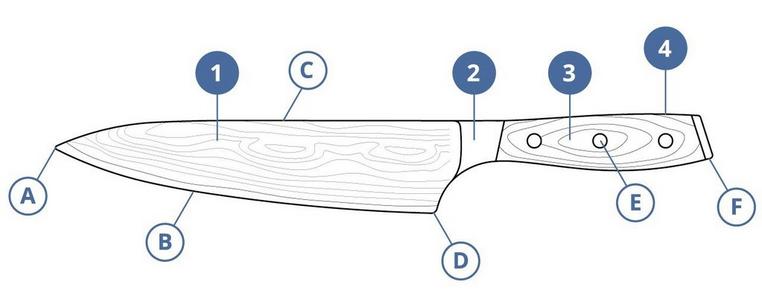Which parts are a kitchen knife comprised of? We will explain!
In many of our topics and articles we use specifications and terms that, to us, are quite obvious, but perhaps not to everyone. Have you completely lost track when it comes to a crop, blade and handle? Continue reading because we would love to tell you more.
1. Blade
The blade is the most important part of a knife. The quality of the blade determines the quality of the knife.
A: The tip: we call the end of the blade the tip;
B: Cutting edge: the cutting edge, also called the edge, is the sharpened part of the blade;
C: Spine: we call the thick, blunt top of the blade the spine.
2. Crop
The crop, also called the knife guard, is there to protect your hand. There are many knives with a crop that run towards the heel. Japanese knives are usually not enhanced with a crop.
D: Heel: the heel is the last part of the edge. To protect your fingers the heel often isn't sharpened.
3. Handle
The handle is the part of the knife you use to hold it. The handle needs to feel great in hand. This depends on the design and the materials used.
E. Rivets: some handles are secured with rivets for a classic look and feel. The rivets keep the two parts of the handle together;
F. Pommel: the pommel is the final part of the handle. The pommel takes care of the balance. If a knife is enhanced with a heavy blade the pommel is often made from metal to counterbalance the weight of the blade.
4. Tang
The tang is the elongated part of the blade where the handle, the crop and the pommel are mounted on. That is when the tang runs all the way to the pommel. It leaves you with a solid construction because there is no wiggle room between the blade and the handle. Check out all kitchen knives.








